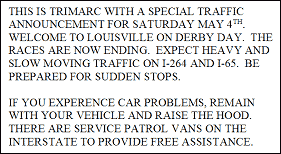
Managing Travel for Planned Special Events
Chapter Six. Traffic Management
Plan
Page 9 of 9
Traffic Surveillance Plan 
A traffic surveillance plan can include:
- Closed-circuit television systems
- Field observation
- Aerial observation
- Media reports
Closed-Circuit Television Systems
Closed-circuit television systems have been used for many years to provide visual surveillance of the highway network. Control centers typically use CCTV systems for the following purposes:
- Detection and verification of incidents
- Monitoring traffic conditions
- Monitoring incident clearance
- Verifying message displays on changeable message signs
For fixed location CCTV systems, video cameras are permanently mounted either on existing structures along the roadway or on specially installed camera poles. This type of system consists of various components, including the following:
- Video camera unit
- Mounting structure (existing or installed)
- Controller cabinet housing the control equipment
- Communication system connecting camera to control center
- Video monitors and camera controls located in control center
CCTV systems allow operations personnel to visually monitor sections of roadway and to react directly to the actual conditions on the roadway. Since operators can lose interest if required to constantly view CCTV monitors, and may fail to notice incidents immediately after they occur, current systems are being designed to automatically position cameras at suspected incident locations (as signaled by incident detection algorithms) and to alert the operator.
Portable CCTV Systems
Portable CCTV systems can serve several purposes including the following:
- Short-term traffic monitoring in areas with non-recurring congestion (e.g., corridor serving a planned special event venue, work zone, critical incident, detours, etc.)
- Traffic monitoring at special traffic generators for planned special events
- Traffic monitoring along evacuation routes
- Determination of optimum camera location for fixed location CCTV systems
Portable CCTV systems are typically mounted in a light truck or van or on a trailer. Components of a portable system include the following:
- Camera with pan-tilt-zoom capability
- Telescopic boom
- Television monitor
- Video recorder
- Camera control unit for controlling pan, tilt, and zoom functions
- Generator for powering equipment; or battery power with solar charging
- Air compressor for operating telescopic boom
- Wireless communications (It should be noted that during planned special events, cellular capacity is strained, and as such, there is a risk of failing communications to portable surveillance systems with cellular communications.)
Figure 6-57 shows a portable CCTV camera, mounted on an overhead sign structure, used for freeway surveillance during a planned special event.
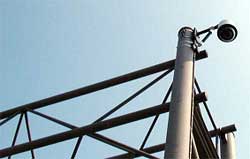
Figure 6-57. Portable CCTV Camera for Freeway Surveillance
Temporary CCTV camera installation requires consideration of video image transmission, and limited communications options may exist. Telephone lines and cellular channels facilitate the transmission of compressed or slow scan video. The transmission of real-time motion video requires infrastructure such as fiber optic cable, coaxial cable, or wireless (e.g., spread spectrum radio).
Closed-circuit television surveillance is a very valuable planned special event management tool for observing real-time conditions related to special event corridors, alternate routes, parking and pedestrian conditions, as well as for a verification tool for messages placed on changeable message signs.
Field Observation
A common and efficient technique to observe the traffic conditions during a planned special event is to place human observers, or detectors, in the field, usually at critical locations. Normally, these observers have the role of monitoring conditions and reporting back to a central location for strategic assessment. These human detectors are gathering relevant information related to the event and using established protocol to communicate the information back to the central processing and coordination facility.
It is common to deploy these observers where technology is lacking and where they may perform an additional role in traffic management or traffic incident management (e.g., freeway service patrol operators). For instance, an observer may be placed at a critical pedestrian location, where besides reporting back to central command on the status of the location, the observer may serve the role of a traffic engineer by adjusting the signal timing to better accommodate the pedestrian volumes.
Aerial Observation
Aerial surveillance has long been used to monitor the operation of the surface transportation network. "Observers" in aircraft (fixed wing or helicopters) fly over freeways and streets and monitor conditions in real-time, using two-way radios to communicate with the TMC or with service patrols on the freeway. This approach can be relatively expensive when one considers the expense of leasing or operating an aircraft, although it does have the benefit of being able to cover a large area.
An emerging trend is the use of remote sensing via unmanned aerial vehicles, similar to airborne platforms/drones used by the military, and satellites. Information gathered from satellite, aircraft, and unmanned aerial vehicles can be used to estimate arterial and freeway traffic characteristics over long time scales and large geographic areas, including those where data were previously unavailable. The spatial coverage provided from air- and satellite-based sensors can potentially support the development of new metrics that better represent highway utilization and congestion.
Media Reports
As discussed earlier, the media needs to be a partner in the planned special event management and operations effort. Agreements must be in place that define their role within the plan, as well as what information needs to be communicated, both prior to and during the event.
The primary disadvantage of using the media relates to the accuracy of the information. Traffic reports often are transmitted only when normal scheduling permits. This may cause considerable time delays between when a condition changes and when the media reports it. Often, many problems go unreported or are cleared by the time they are reported on the radio and television. The accuracy of the information provided by commercial radio, for instance, is a function of the time between the broadcaster's last communication with the incident reporting source and the number of incidents that have occurred and/or have been cleared during that time.
Some transportation agencies have made substantial efforts to improve coordination and cooperation between themselves and the media traffic reporters. For example, some agencies allow private traffic advisory services to place personnel in the TMC to obtain information on traffic conditions and expected agency responses in an accurate and timely manner.
Traffic Incident Management and Safety Plan 
Overview
The occurrence of a planned special event that increases or disrupts the normal flow of traffic places a premium on the optimal use of existing facilities. A traffic incident and safety plan specifies crash prevention tactics and traffic incident quick clearance initiatives, some of which denote special provisions enacted just for the day-of-event. These traffic incident management techniques preserve two goals of managing travel for planned special events: (1) ensuring safety and (2) maximizing efficiency. In the event of a major traffic incident that blocks travel lanes for a prolonged duration, the traffic management team should refer to response procedures and guidelines contained in an established traffic incident management manual for the region.
Crash Prevention Tactics
Crash prevention tactics focus on improving driver awareness of surroundings and driver behavior. Table 6-38 lists crash prevention tactics applicable to planned special events.
| Tactic |
|---|
|
Portable Lighting
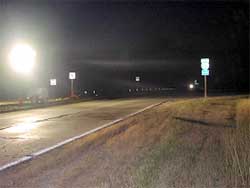
Figure 6-58. Portable Lighting (Photo courtesy of the Wisconsin DOT.)
Portable lighting devices enhance driver understanding of traffic control and traffic flow patterns at night. As shown in Figure 6-58, the devices prove particularly useful at rural, unlit freeway interchanges or arterial target points that handle high-volume turning movements during event ingress and egress. Portable lighting makes traffic control officers more visible to approaching drivers, and in the vicinity of the event venue, the devices can spotlight pedestrian/vehicular conflict areas.
Congestion Warning Signs
Congestion warning signs, placed upstream of known roadway bottleneck locations, alert drivers of demand-induced congestion on the day-of-event. The tactic aims to prevent rear-end crashes as a result of drivers encountering unexpected congestion. Stakeholders should strongly consider deploying congestion warning signs along event ingress and egress routes containing significant geometric curves. In order to control message display and preserve its credibility, consider deploying portable changeable message signs or static signs that hinge open, as shown in Figure 6-59.
Public Information Safety Campaign
A public information safety campaign strives to change motorists' behavior when traveling to and from a planned special event. Campaigns emphasize event traffic control and regulations, pedestrian safety, and vehicle operation. For example, the Louisiana DOT launched a $94,000 public information campaign in 2002 to reduce the number of crashes caused by drivers following too closely.(23) The campaign targeted spectators attending Louisiana State University football games through advertisements on radio stations carrying the games and advertisements in game-day football programs. The advertisements specified driver tips on how to avoid tailgating.
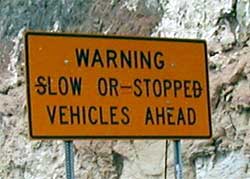
Figure 6-59. Congestion Warning Sign
Enforcement
Enforcement aims at preventing drivers from executing illegal and dangerous movements in an effort to bypass congestion and/or day-of-event traffic control. For instance, drivers attempting to access a freeway may travel past a congested entrance ramp serving egress traffic, make an illegal U-turn, and traverse an uncongested freeway entrance ramp from the opposite direction. The behavior of one motorist provokes other motorists to execute the same maneuver.
Service Patrols
Service patrols function to typically satisfy the incident detection, verification, response, and removal components of incident management in the event of a minor incident, such as a vehicle disablement or property-damage-only crash. Patrol operators strive to identify and remove debris or hazards impeding traffic flow, and they aid in the fast removal of immobilized or wrecked passenger cars blocking one or more travel lanes. Service patrol programs create a sense of security for motorists in addition to improving public relations for the service's sponsor. Other examples of motorist assists that are typically offered free of charge include supplying fuel, changing flat tires, providing a jump-start, and calling private towing companies.
Service patrols can play a key role in traffic incident management for planned special events. The service has great versatility, and patrol operators can satisfy a wide range of traffic management team needs. For example, operators can assist in establishing day-of-event traffic control, performing traffic surveillance, and providing timely traffic condition reports from various remote locations. As shown in Figure 6-60, service patrols carry equipment to support traffic management at incident sites and congestion locations.
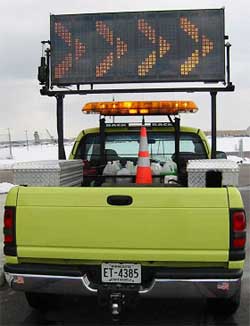
Figure 6-60. Service Patrol Vehicle (Graphic courtesy of the Minnesota DOT.)
Table 6-39 indicates considerations in preparing a service patrol operations plan for a planned special event. To avoid having drivers abandon disabled vehicles or risk exposure to adjacent traffic flow, stakeholders should alert roadway users of service patrol operation on the day-of-event via roadside traveler information devices. Figure 6-61 shows a special event HAR message disseminating safety tips to drivers and promoting service patrol operation.
Traffic Incident Quick Clearance Initiatives
Quick clearance is the practice of rapidly and safely removing temporary obstructions from the roadway.(25) Quick clearance practices increase the safety of traffic incident responders and victims by minimizing their exposure to adjacent passing traffic. A reduced probability of secondary incidents accompanies decreased congestion levels resulting from fast removal of lane-blocking obstructions.
A quick clearance practice consists of laws, policies, procedures, and infrastructure aimed at effecting the safe and timely removal of a traffic incident. Service patrols, as previously described, represent a quick clearance infrastructure component. Rapid clearance of traffic incidents during planned special event ingress and egress avoids significant impact to corridor and local traffic flow routes in addition to routes used by participants and VIPs.
The following quick clearance initiatives benefit traffic incident management in high-volume corridors, characteristic of planned special events: (1) vehicle/cargo removal laws and policies, (2) stakeholder open roads policy, and (3) public-private towing contracts. Vehicle removal laws require drivers to immediately move vehicles obstructing travel lanes. Also, agencies have authority to aggressively clear vehicles and spilled cargo without incurring unnecessary delay. Similar policies establish no stopping zones in highly traveled locations. An interagency open roads policy informs traffic incident responders of the urgent need to rapidly remove disabled or wrecked vehicles, spilled cargo, and debris that obstruct the normal flow of traffic, and the policy disseminates key guidelines to ensure a cooperative incident removal effort between agencies. Chapter 5 discusses contract towing service for planned special events.
Practitioners should consult NCHRP Synthesis 318, Safe and Quick Clearance of Traffic Incidents, for state-of-the-practice information about laws, policies, procedures, infrastructure, and technologies associated with developing a quick clearance practice and increasing the efficiency of traffic incident removal operations.(25)
Quick clearance represented the overarching theme within the Utah DOT traffic incident management plan for the 2002 Winter Olympics. Table 6-40 summarizes some notable quick clearance strategies contained in the event traffic incident management plan. The table also states statistics and performance measures that conclude the Utah DOT, together with its partner law enforcement and transportation agencies, developed and deployed a successful quick clearance practice for the Olympics.
| Strategy |
|---|
|
| Evaluation Statistic |
|---|
|
References
1. Glazer, L.J. and R. Cruz, Intelligent Transportation Systems at the 2002 Salt Lake City Winter Olympic Games: Event Study — Traffic Management and Traveler Information, Utah Department of Transportation, Salt Lake City, Utah, April 2003, 160 pp.
2. Burdette, D., "An Evaluation of Advanced Parking Information Systems at Airports," Prepared for the 2001 Annual Meeting of the Transportation Research Board, National Research Council, Washington, D.C., January 7–11, 2001.
3. Advanced Parking Information System Evaluation Report, Minnesota Department of Transportation, St. Paul, Mn., 2000, 52 pp.
4. Gibson, P.A. and A.D. Rifkin, "An Integrated Event Parking and Circulation Management Plan for the Staples Center and the Los Angeles Convention Center," Prepared for the ITE 2000 Annual Meeting and Exhibit, Institute of Transportation Engineers, Nashville, Tn., 2000.
5. Dunn, Jr., W.M., "Traffic Management for 1995 U.S. Open," Preprint No. 00131, Prepared for the ITE 2001 Annual Meeting and Exhibit, Institute of Transportation Engineers, Chicago, Il., August 19–22, 2001.
6. The Dutchess County Fair Traffic Plan, New York State Department of Transportation, Presentation at the 2002 ITS New York Meeting, Saratoga Springs, Ny., June 5–7, 2002, 24 pp.
7. McBride, J., Utah Department of Transportation, Personal Communication, July 14, 2003.
8. Kelman, L., "World Youth Day 2002 – Transportation Planning and Operations," Presented at the 82nd Annual Meeting of the Transportation Research Board, Washington, D.C., January 12–16, 2003.
9. Highway Capacity Manual, Transportation Research Board, National Research Council, Washington, D.C., 2000.
10. Shell Grand Prix of Denver – Parking and Traffic Management Plan, Prepared for the Grand Prix of Denver by URS Corporation, August 2002, 33 pp.
11. Coffel, B. and F. Wambalaba, Tri-Met SETS Program, Tri-County Metropolitan Transportation District of Oregon, Portland, Oregon, 1995.
12. Traffic Management for Special Events, Version 6, New South Wales Roads and Traffic Authority, Australia, February 2002, 82 pp.
13. Dunn, W.M., R.A. Reiss, and S.P. Latoski, Roadway Incident Diversion Practices, NCHRP Synthesis 279, Transportation Research Board, National Research Council, Washington, D.C., 1999, 84 pp.
14. Suggs, E., "Festival to Test New Traffic Plan," Atlanta Journal-Constitution, April 8, 2003.
15. Volz, M.A. and B.J. Nicholson, "Kansas Speedway Event Management Using ITS," n.d.
16. Dudek, C.L., Guidelines for Changeable Message Sign Messages, Federal Highway Administration, Washington, D.C., September 2002 (Draft), 256 pp.
17. Wolshon, B., "'One-Way-Out': Contraflow Freeway Operation for Hurricane Evacuation," Natural Hazards Review, Vol. 2, No. 3, August 2001, pp. 105–112.
18. Daytona Beach Traffic Engineering Speed Weeks 2002, City of Daytona Beach Public Works, 2002.
19. Anaheim Special Event Manual, City of Anaheim Department of Public Works (Draft), Anaheim, Ca., 2002, 40 pp.
20. Transport Management Plan: New South Wales Bush Fire Parade, Version 1, New South Wales Roads and Traffic Authority, Australia, February 2002.
21. Schuman, R. and E. Sherer, "511 '101'," 511 Deployment Conference, Scottsdale, Arizona, March 2002.
22. "Inside ITS," Volume 13, No. 7, April 1, 2003, p. 3.
23. Anderson, A., "Program Will Try to Put the Brakes on Tailgating," The Times-Picayune, September, 5, 2002.
24. Derby Day Plan, Traffic Response and Incident Management Assisting the River Cities, May 2002.
25. Dunn, W.M. and S.P. Latoski, Safe and Quick Clearance of Traffic Incidents, NCHRP Synthesis 318, Transportation Research Board, National Research Council, Washington, D.C., 2003, 143 pp.
26. National Conference on Traffic Incident Management: A Road Map to the Future, March 11–13, 2002: Proceedings, American Association of State Highway and Transportation Officials, Washington, D.C., 2002.
Planned Special Events Traffic Management | Privacy Policy
